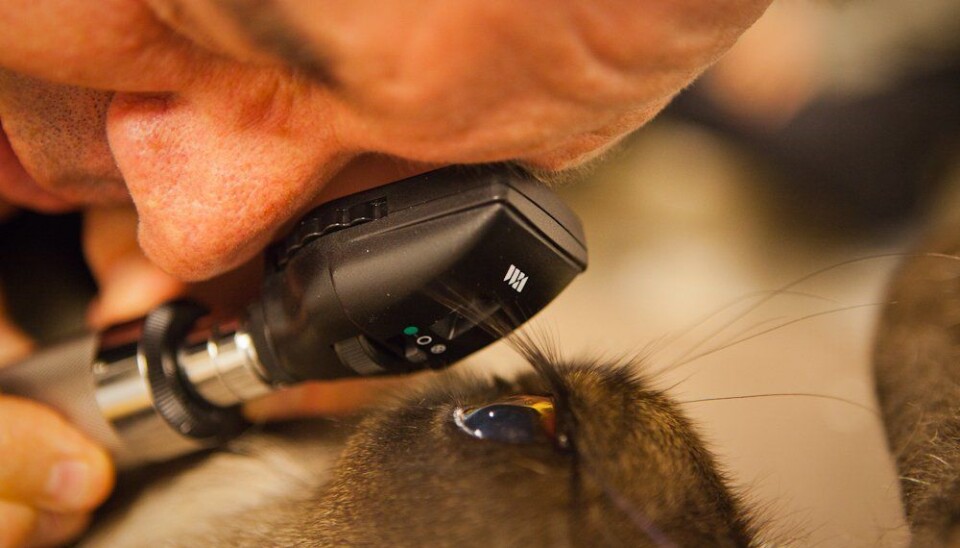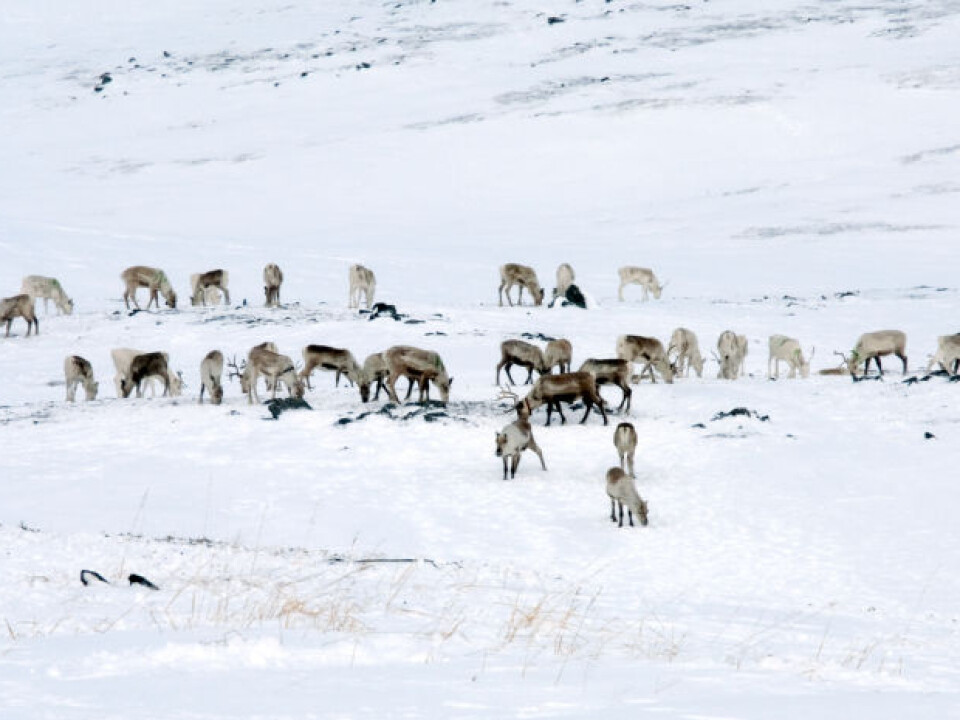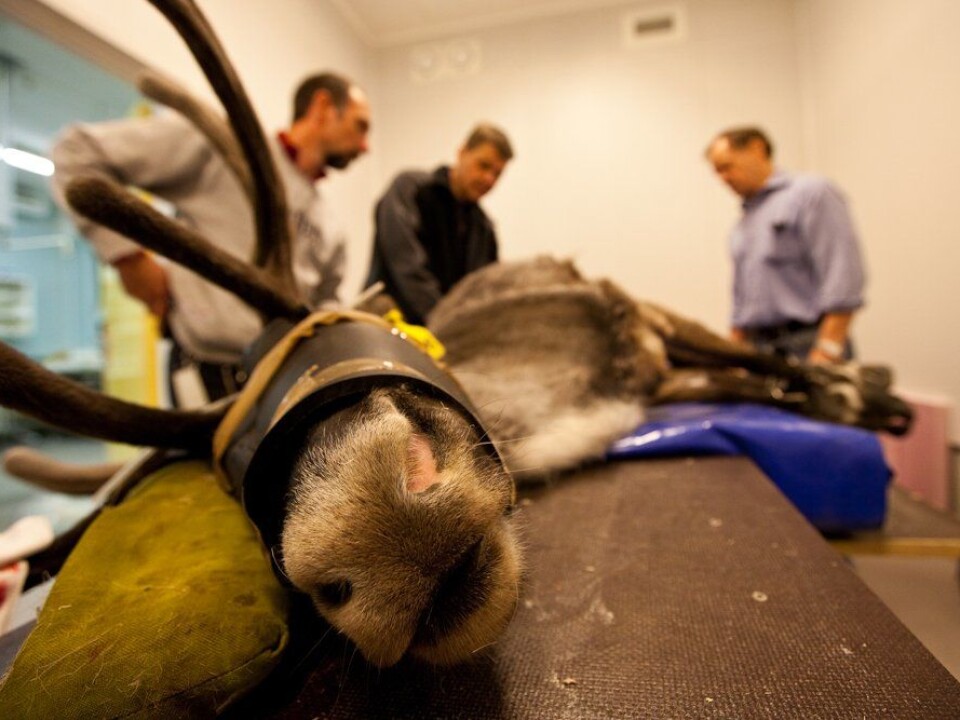
Rudolph and relatives have UV vision
The reindeer of the high north can see light that is invisible to our eyes. This is a big advantage in a snow white landscape.
Denne artikkelen er over ti år gammel og kan inneholde utdatert informasjon.
Video from the British Biotechnology and Biological Sciences Research Council, which has contributed financially to the research. The study was published in May 2011, but has certain Christmas relevance.
UV-vision can help reindeer see lichen that is concealed beneath the snow, or a wolf that is trying to sneak up on them.
This can also mean that reindeer are better than us at navigating in a landscape which we see as white and un-contoured.
Wavelengths

Light is electromagnetic radiation and can be perceived as waves. For humans visible light is limited to a narrow electromagnetic wave range of 400 to 700 nanometres.
Picture the spectrum of a rainbow. Red is in the upper level of the visible light scale, at a wavelength of about 700 nanometres. At the bottom is violet.
But light isn’t limited to that range. Below 400 nanometres we have ultraviolet light, or UV radiation.
Snow blindness

Our eyes cannot see it – UV rays are harmful to our optic organs and are thus blocked before they reach the retina.
The cornea at the front of the eye stops and absorbs UV rays. But if bombarded by the rays the corneas can be burned. Our eyes become fogged up, they are painful and we call it snow blindness.
The eyes of reindeer in the Arctic, however, admit and register UV light all the way down to a wavelength of 320 nanometres.
The way reindeer see the world

Karl-Arne Stokkan at the University of Tromsø is a professor of Arctic biology, and one of the researchers behind this discovery.
“Reinsdeer can see in the ultraviolet spectrum. We’ve measured this with an electroretinagram,” he says.
This is a standard method for registering the stimuli an eye registers. When cells in the eye send signals, the instrument can detect a weak electric activity.
This doesn’t tell scientists exactly how reindeer perceive their environment. For instance they don’t know if UV radiation is seen as black and white or in colour.
“We’ll probably never know what the world looks like to a reindeer,” says Stokkan.
Snow is highly reflective
What is certain, however, is that a lot of UV light is reflected off snow (nearly 90% of it when the snow is pure and white). In addition light of a shorter wavelength (blue and ultraviolet) is diffused more easily in the atmosphere than for instance, red.
The sun is lower in the sky in the far north, and light thus has to travel through more of our atmosphere; the proportion of UV light to other light in the polar areas is higher than it is closer to the equator.
This is true even though the total amount of UV light is higher toward the equator (Northern Europeans are more prone to get sunburned on vacation in, for instance Crete, than they would at home).
The larger share of light with short wavelengths explains why winter evenings can look so blue.
Cameras that register UV light suggest to researchers what reindeer gain from registering this area of the spectrum.
Lichen and wolves
“It appears that they get more contrast, which helps them see the plants they graze on,” says Stokkan.
Many of the plants eaten by reindeer, particularly the lichen of the genus Cladonia, absorb UV light. The contrast between a reflective snow surface and light-absorbing lichens should thus be high in the UV wavelengths.
“The fur of lots of animals also absorbs UV light and would stand out with stronger contrast against a snow white landscape,” explains Stokkan.
This could make it easier for reindeer to spot wolves, who are their mortal enemies.
“Seeing food and predators better is certainly a survival advantage that would get passed on through evolution,” reasons Stokkan.
Was expected
Reindeer are the first large mammals that have been shown to have UV vision.
“Our partners in cooperation say they had expected this. Maybe we humans are exceptional because we don’t see in this area of the spectrum,” says Stokkan.
UV-vision has previously been detected in birds, bats, small rodents and insects. Bees have advanced colour vision and can see well in ultraviolet light.
Snow quality
Better perception of food and predators is not the only possible advantage of UV vision for reindeer.
Researchers know that snow reflects UV radiation from diverse qualities of snow differently – for instance if it is new, old, dry or wet.
“This could mean that reindeer can easily get information about the snow this way,” says Stokkan.
Skiers can experience a so-called whiteout, where a snowy landscape loses all its contours and is totally without structure.
“This can occur when the sun is shining through a thin layer of clouds on a snowy landscape. Suddenly you see no depth or contrasts and don’t know if you are going up or down, if there is a gap or a cliff right ahead of you or what.”
“With UV vision it’s conceivable that reindeer see contrasts much better in a white landscape.”
“We can’t be sure about this, because we often hear about reindeer walking off a cliff, but we are open for speculation about how this ability can be used,” says Stokkan.
Navigates
Scientists know that insects can use UV light to orient themselves by the sun even when it is hidden behind clouds.
“UV light is polarized differently than visible light, and it can give an impression of where the sun is in the sky, even with a thick cloud cover. Reindeer migrate from winter grazing areas to summer ones and they need to navigate their way.
The point of departure for the research was an interest in the eyes of animals that live in extreme light conditions.
“We found some abilities that can be associated with living in extreme light conditions at high latitudes, but it could be that they are common for animals in general, because nobody has investigated this before,” says Stokkan.
Only one previous study like this has been made on members of the deer family, an American study of red deer which did not find any sign of their eyes registering ultraviolet light.
“That makes us think along the lines of this being an Arctic adaptation,” says Stokkan.
Plans to test other animals
The researchers plan to test other animals, starting with seals.
“This is something of a paradox because UV radiation is easily absorbed by water, but UV vision could be possible just below the surface and lots of seals feed on the ice or right below the surface,” says Stokkan.
He thinks the ability to see UV light is more common than we have imagined.
Stokkan says that he and his team have conducted experiments indicating that reindeer also see better in the blue range of the light spectrum in the winter than in the summer. Their eyes undergo changes seasonally. This discovery has not been published yet.
-----------------------------------
Read this article in Norwegian at forskning.no
Translated by: Glenn Ostling

































